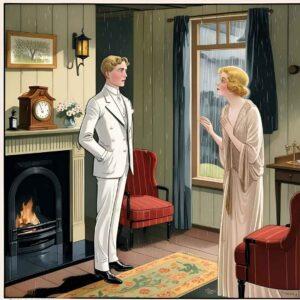Can even the most meticulously planned reunion truly repeat the past?
Following Chapter 4’s pivotal revelations, F. Scott Fitzgerald’s The Great Gatsby arrives at its emotional apex in Chapter 5. This chapter stages Jay Gatsby’s intense, awkward, and revealing reunion with Daisy Buchanan, an encounter he’s pursued for half a decade.
As narrator Nick Carraway facilitates, you’re placed directly within the charged atmosphere where Gatsby’s idealized dream forcefully collides with present reality.
First, read our The Great Gatsby chapter 5 summary of the chapter’s key events, followed by our detailed analysis arguing that this encounter marks hope’s peak while simultaneously sowing disillusionment, all viewed through potent symbolism and Nick’s crucial observations.
(For context on the events leading up to this, see the Chapter 4 Summary & Analysis.)

The Great Gatsby Chapter 5 Summary of Events
Nick Carraway orchestrates the long-awaited meeting between Gatsby and Daisy at his cottage, witnessing Gatsby’s intense nervousness transform into joy, wonder, and perhaps the first shadow of doubt.
Anxious Anticipation: Gatsby’s Preparations
Returning home late one night, Nick finds Gatsby’s mansion blazing with light but strangely silent. Gatsby emerges, agitated, and invites Nick several times for impromptu recreation before Nick confirms he’ll host Daisy for tea the day after next.
Visibly relieved, Gatsby offers to have Nick’s lawn mown, a subtle jab at its state compared to his own manicured expanse, then awkwardly attempts to offer Nick a “confidential” side business opportunity.
Nick, uncomfortable with the apparent payment for facilitating the meeting, firmly declines but assures Gatsby he’ll arrange the tea.
The Rainy Day Reunion: Awkward Beginnings
The arranged afternoon arrives with pouring rain. Nevertheless, Gatsby has Nick’s lawn cut and floods his cottage with flowers from his greenhouse. Gatsby dresses impeccably (white flannel suit, silver shirt, gold tie) but looks pale, sleepless, and extraordinarily nervous.
When Daisy’s car pulls in, Gatsby panics and bolts out the back door, only to circle and reappear moments later at the front, rain-spattered and feigning composure.
The initial meeting in Nick’s living room is painfully awkward. Hands jammed in his pockets, Gatsby leans stiffly against the mantelpiece, nearly knocking over Nick’s defunct clock. He catches it with trembling fingers.
Conversation falters; Gatsby mutters about the mistake of the meeting, while Daisy attempts strained, artificial pleasantries.
A Shift in Atmosphere: Joy and Tears
Sensing the need for “physical decency” amidst the awkwardness, Nick makes an excuse about needing to attend to the tea preparations in the kitchen and leaves Gatsby and Daisy alone for half an hour.
When he returns, the tension has vanished. Gatsby radiates a joy that Nick describes as “literally glowing.” Daisy, face smeared with tears, appears overcome with happiness.
While Daisy goes upstairs (ostensibly washing her face, causing Nick humiliation regarding his towels), Gatsby, alone with Nick on the lawn, perhaps caught up in the moment, unthinkingly contradicts his earlier backstory. He tells Nick he earned the money for his house in just three years, rather than inheriting it, before quickly correcting himself about losing most of an inheritance in the “panic of the war.”
The Grand Tour: Gatsby Displays His World
With the rain easing to mist, Gatsby insists on showing Daisy (and Nick) his mansion. He leads them through opulent rooms, briefly encountering the “boarder,” Klipspringer, doing exercises.
Nick observes Gatsby watching Daisy intently, seeming to gauge the value of his possessions solely by her reaction. In his bedroom, notably simple aside from a solid gold toilet set where Daisy later delights in smoothing her hair with his brush, Gatsby opens his cabinets.
He begins throwing piles of his expensive, imported shirts onto the bed, shirts of “sheer linen and thick silk and fine flannel,” in vibrant colors like “coral and apple-green and lavender and faint orange.” Overwhelmed by this display of material wealth aimed directly at her, Daisy suddenly buries her face in the shirts and sobs, crying out about their beauty.
Fleeting Moments and Fading Enchantment
As the rain subsides and pink clouds appear, Daisy gazes out the window and whimsically tells Gatsby, “I’d like to just get one of those pink clouds and put you in it and push you around.”
Gatsby points out Daisy’s home across the bay, visible now through the mist, and mentions the green light at the end of her dock. Nick notes that the light’s “colossal significance” seems to have vanished for Gatsby now that Daisy is close.
After Nick inquires about a large photograph over Gatsby’s desk, Gatsby identifies it as Dan Cody, his deceased former mentor. Unlike on previous occasions, Gatsby dismisses an incoming phone call quickly,
He then requests Klipspringer to play the piano. Klipspringer reluctantly plays the cheerful tune ‘Ain’t We Got Fun?’, creating sharp situational irony. The upbeat melody clashes jarringly with the scene’s underlying tension and the profound emotional weight of Gatsby and Daisy’s reunion, highlighting the superficiality that often masks deeper complexities in their world.
Departure and Doubt
As Klipspringer plays, Nick realizes Gatsby and Daisy are completely absorbed in each other, having forgotten his presence entirely. He quietly departs, leaving them alone.
Walking away, Nick reflects on the afternoon. He senses a subtle shift in Gatsby, a “faint doubt” creeping into his apparent ecstasy.
Nick speculates that Daisy, the real woman, must have, at moments, inevitably “tumbled short of his dreams”, not due to any failing on her part, but because Gatsby’s illusion had grown to such “colossal vitality” over five years that no reality could match it.
Chapter 5 Analysis: The Dream Confronts Reality
Chapter 5 masterfully stages the collision between Gatsby’s five-year obsession and the complex reality of Daisy within the material world built to win her. Fitzgerald uses potent symbolism, acute character reactions, and Nick’s insightful observations to mark hope’s zenith and the subtle beginnings of its unraveling.
The Weight of Expectation: Analyzing the Awkward Reunion
Gatsby’s intense nervousness, pallor, trembling hands, and the near-destruction of Nick’s clock visibly depart from his usual composure, revealing the immense pressure invested in this encounter. His panicked flight out the back door, only to formally reappear at the front, rain-spattered, highlights his desperate need to control the presentation despite overwhelming anxiety.
The clock incident resonates symbolically: his fumbling attempt to catch the defunct timepiece mirrors his larger, desperate effort to stop and recapture elapsed time, showcasing the inherent clumsiness and fragility of trying to manipulate the past.
The initial, agonizing silence between Gatsby and Daisy emphasizes the chasm created by five years of separation and Gatsby’s towering expectations. His muttered admission to Nick, “This is a terrible mistake,” reveals his immediate fear that the present reality cannot bridge that divide.
The dramatic shift after Nick leaves them alone suggests their shared history’s undeniable power, allowing Gatsby’s radiance to eclipse his anxiety. Daisy’s whimsical declaration to Gatsby as the rain clears, “I’d like to just get one of those pink clouds and put you in it and push you around”, vividly captures their rekindled connection’s dreamlike, almost surreal quality.
While playful, the image hints at her desire to gently control and situate Gatsby within her romantic fantasy, an ethereal vision that helps her escape the looming complexities of their real-world situation and perhaps mirrors Gatsby’s idealization of her.
Yet, even in his joy, Gatsby’s unthinkingly contradictory statements about his wealth reveal cracks, exposing his constructed identity’s instability at this apparent triumphant moment.
Weather as Mirror: Rain, Sun, and Fragile Hope
Fitzgerald skillfully employs pathetic fallacy, the literary technique where nature mirrors a character’s emotions, aligning the chapter’s downpour with Gatsby’s intense anxiety before the reunion. The initial “pouring rain” externalizes his internal anxiety and the gloomy weight of anticipation.
The emerging sun signifies radiant joy and the reunion’s apparent success once the initial barrier is broken, implying Gatsby’s internal state can metaphorically shape his world, a key facet of his romantic idealism.
The shift isn’t absolute, however. The lingering “damp mist” that later obscures the green light across the bay becomes symbolically significant.
While the storm of Gatsby’s anxiety has passed, perfect clarity remains elusive. It subtly suggests that achieving the dream Daisy presents, ironically, obscures the idealized vision or reveals its fundamental unattainability, foreshadowing complications.
Performing Wealth: The House Tour and Materialism
The tour through Gatsby’s mansion transcends a simple display of riches; it’s a calculated performance, the physical embodiment of the success Gatsby believes necessary to win Daisy.
Nick’s crucial insight, that Gatsby “revalued everything in his house according to the measure of response it drew from her well-loved eyes”, exposes materialism as Gatsby’s primary love language. His possessions gain meaning only through her validating gaze, suggesting a concerning objectification of his wealth and, perhaps, Daisy.
The house transforms into a stage designed for her approval. Gatsby’s slight reproach directed at Nick’s servant, the Finn, regarding the tea preparations, underscores his meticulous control over every detail of this performance.
The contrast between opulent guest areas and Gatsby’s comparatively simple bedroom (the gold toilet set notwithstanding) hints that much of the grandeur is performative, not intrinsic to his taste.
Klipspringer, the “boarder” casually doing exercises, symbolizes the hangers-on wealth attracts, subtly undercutting the scene’s romantic aspirations.
“Such Beautiful Shirts”: Decoding Daisy’s Tears

Daisy’s intense weeping over Gatsby’s shirts is a pivotal, much-analyzed moment. More than simple appreciation, her tears likely spring from a complex emotional vortex, potentially revealing several conflicting feelings simultaneously:
- Shock and Overwhelm: The sheer, tangible scale of Gatsby’s wealth expended for her.
- Sorrow and Regret: Mourning lost time and the different life she might have had if she’d waited.
- Recognized Disparity: A painful awareness of the gap between Gatsby’s unwavering idealism and her life choices driven by pragmatic security.
- Material Longing: Perhaps partly a reaction to the immense luxury, representing the specific blend of love and material comfort she desires.
This powerful scene crystallizes the novel’s tragic intertwining of love and money. The shirts symbolize Gatsby’s entire achievement laid bare, prompting Daisy’s ambiguous emotional capitulation, overcome not just by sentiment but by the overwhelming physical evidence of devotion expressed through extravagant material wealth.
The Diminished Green Light: Shifting Symbols
Gatsby pointing across the misty bay towards Daisy’s dock prompts Nick’s critical observation about the green light: its “colossal significance… had now vanished forever.”
Previously, the distant light symbolized the almost mystical, unreachable ideal of Daisy and the past. Now, with Daisy physically beside him, that bright symbol dims, becoming merely “a green light on a dock.”
This symbolic deflation powerfully underscores a central theme: pursuing a dream is often more enchanting than attaining it. The tangible reality, however desired, cannot sustain the “colossal vitality” of the idealized illusion Gatsby nurtured for five years.
This diminishing “enchanted object” foreshadows the reunion’s ultimate inadequacy in fulfilling Gatsby’s impossibly grand expectations.
Gatsby’s Internal State: From Glow to Doubt
Fitzgerald meticulously charts Gatsby’s emotional trajectory, showcasing vulnerability beneath the facade. He progresses from paralyzing anxiety (“pale as death”) to radiant joy (“literally glowed”), then into possessive “wonder” at Daisy’s presence.
Yet, this emotional peak is unsustainable. Nick perceives the subtle return of “bewilderment,” interpreting this shift as Gatsby sensing Daisy might have “tumbled short of his dreams.”
Nick’s metaphor of Gatsby “running down like an overwound clock” captures the exhausting intensity and inherent fragility of maintaining such a frenzied emotional climb.
The dream, so long nurtured in isolation, encounters reality’s friction. This internal shift signals the beginning of the dream’s inevitable fracture when confronted with present circumstances.
Nick’s Complicated Role: Facilitator and Observer
Nick’s role evolves significantly. No longer just an adjacent observer, he becomes complicit as the reunion’s facilitator, actively arranging tea and managing the initial awkwardness. His participation binds him more closely to events.
Simultaneously, he maintains keen observational distance, analyzing Gatsby’s reactions, interpreting Daisy’s tears, and perceiving symbolic shifts.
His crucial concluding interpretation of Daisy falling short of Gatsby’s illusion isn’t an objective fact; it’s his reasoned assessment from observing Gatsby. This framing reinforces Nick’s narrative control while highlighting his subjective lens, reminding you to evaluate his perspective continually.
Chapter 5: The Dream’s Zenith and Its Fracture
Chapter 5 marks the apex of Gatsby’s quest, staging the violent collision of his idealized past with present reality. Through powerful symbolism, evocative weather, the fumbled clock, overwhelming shirts, and the diminished green light, Fitzgerald showcases the reunion’s intense joy and inherent instability.
Though Gatsby momentarily achieves his goal, Daisy’s physical presence validates his immense effort, and the chapter subtly exposes his dream’s fragility. Materialism’s inadequacy, the impossibility of repeating the past, and the sheer weight of Gatsby’s illusion begin to sow disillusionment, even amidst intense emotion.
This chapter portrays the dream at its most potent while revealing its fatal flaws and begins the inevitable descent as this rekindled connection confronts unyielding realities beyond Gatsby’s mansion.
Having reached hope’s peak, the narrative now explores this reunion’s consequences. Delve into the reactions in our upcoming Chapter 6 analysis, or revisit the broader context in the main The Great Gatsby analysis.
A Note on Page Numbers & Edition:
Like Gatsby arranging his mansion and flowers with painstaking care for Daisy’s arrival, ensuring citation accuracy requires careful attention to the specific edition used. We meticulously sourced textual references for this summary and analysis from The Great Gatsby, Scribner 2020 Paperback edition (Publication Date: September 1, 2020), ISBN-13: 978-1982149482. Always verify page numbers against your specific copy for academic accuracy.
